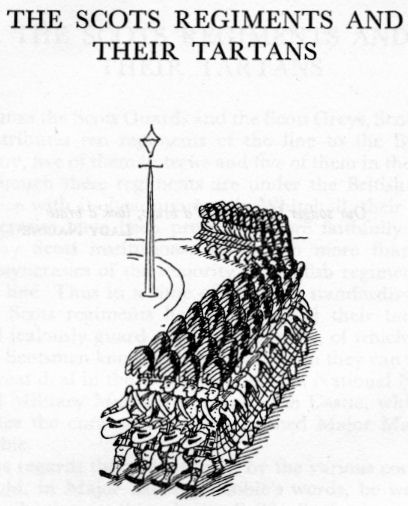|

Our sodger buddies look'd
braw, look'd braw
Lady Nairne
BESIDES the Scots Guards
and the Scots Greys, Scotland contributes ten regiments of the line to the
British Army, five of them in trews and five of them in the kilt. Although
these regiments are under the British War Office with its headquarters in
Whitehall, their idiosyncrasies have been preserved more faithfully than
many Scots institutions, and much more than the idiosyncrasies of the
majority of English regiments of the line. Thus in a time of khaki-ed
standardisation, the Scots regiments have maintained their tartans, and
jealously guard many peculiarities, of which very few Scotsmen know
anything, although they can learn a great deal in the wonderful Scottish
National Naval and Military Museum in Edinburgh Castle, which is under the
curatorship of the learned Major Mackay Scobie.
As regards the tartans worn
by the various corps, it would, in Major Mackay Scobie's words, be well to
describe them as "now known". The Seaforths and the Highland Light
Infantry wear the red-and-white striped tartan, the groundwork of which is
the same as the Black Watch, which may be primarily associated with these
corps and not with the "Clan Mackenzie". Indeed, it seems as if their
patterns had become a clan one, and not the reverse. In any case, they are
regimental setts, the tartan having been invented in 1794. The same is
true of the tartans of the Gordons, the Argyll and Sutherlands, and the
Camerons. The Gordon was first and foremost a regimental sett for the
Fencibles of 1793, and later, for the ducal family. The Camerons have
their own regimental pattern, now described as Cameron of Erracht.
Similarly, the Royal Scots Fusiliers wear the military
pattern tartan, as also did all Lowland regiments at first when dressed in
semi-Highland uniform in 1881, except the Scots Guards and the Scottish
Rifles, both of whom opposed it.
Pipers of various corps wear the old "music" tartan -
that is, Royal Stewart - but the Royal Scots Fusiliers wear Erskine,
granted in 1928. The tendency, indeed, is to emphasise the early history
of the Scots regiments, and especially their connection with the families
which raised several of them.
The accompanying tables show at a glance the chief
differences in the uniforms of the various regiments.
| Old Nos. |
KILTED REGIMENTS |
TARTAN |
SPORRAN |
| 42nd and 73rd |
Black Watch
(1725) |
Black
Watch (29 piped pleats) |
White and
5 short black tassels |
| 72nd and 78th |
Seaforths (1778 and
1793) |
Regimental or Mackenzie (32 box pleats and 2 side) |
White and
2 long black tassels |
| 79th |
Camerons (1793) |
Regimental, or "Erracht
Cameron". (25 box pleats for men: 28 side pleats for officers) |
Black and 2 long white
tassels |
| 75th and 92nd |
Gordons (1787 and
1794) |
Regimental or "Gordon"
(29 to 31 side pleats) |
White and 2 long black
tassels |
| 91st and 93rd |
Argyll and Sutherlands
(1794 and 1799-1800) |
Regimental (27 to 29
box pleats) |
Black and 6 short white tassels |
| Old Nos. |
TREWED REGIMENTS |
TARTAN |
HEDGEAR |
FACINGS |
| 1st |
Royal Scots (Lothian
Regiment) (1633) |
Hunting Stewart |
Kilmarnock Bearskin cap |
Blue |
| 21st |
Royal Scots Fusiliers
(1678) |
Military or Scots
Fusiliers |
|
Blue |
| 26th and 90th |
Cameronians (Scottish
Rifles) (1688 and 1794) |
Douglas |
Chako |
Green |
| 25th |
K.O.
Scottish Borders (1689) |
Leslie |
Kilmarnock |
Blue |
| 71st and 74th |
Highland Light
Infantry |
Regimental or
Machenzie |
Chako (diced) |
Buff |
| |
Scots Guards |
Royal Stewart (Pipers
only) |
Feather bonnet |
Blue |
|

